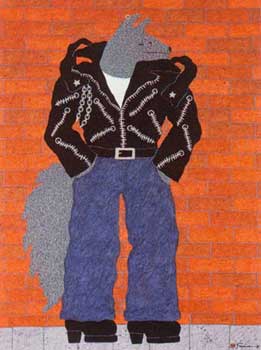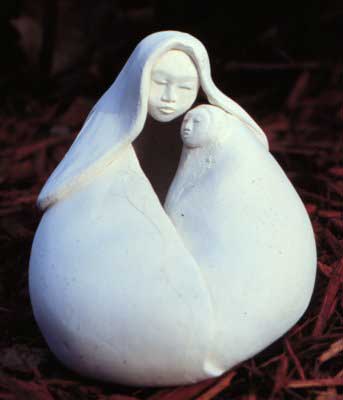|
Native
American Art by Mifaunwy
Shuatona Hines
|
||
| The following article was published in Art Workers News' "Task Force on Discrimination in Art" edition in 1979. The author, Mifaunwy Shunatona Hines, who was instrumental in founding New York City's American Indian Community House, sent it to us. Mifuanwy thought we might enjoy a "peek into my view of the World of Art". Written nearly twenty-five years ago, Mifaunwy's piece begs us to consider the following question: has anything changed since then? What do you think? We at Talking Stick would appreciate your feedback. Talking Stick, C/o AFSC, 15 Rutherford Place, NY NY 10003, Attn: Editor My people, Native American Indians, have among the non-Indian American people almost as many stereotypes as we have tribes: The Stoic, The Drunk, The Savage, The Nobel Red man, The Meek "Squaw", The Proud Princess, The Pathetic Indian: all of these types drawn against the image of a nickel Indian profile or a dream world valiant Pocahontas. We suffer from being asked stereotypical questions also: Are you a real Indian? How do you say something in Indian? Why can't you Indians get together and unite? Can you do the Indian dance? These stereotypes imply that we Native American Indian people are all one and the same. We are not. The American non-Indian's failure to recognize the distinctness of one tribal Nation from one another has resulted in tremendous cultural loss to the United States. Such a monumental oversight might be excused by the fact that the Europeans who first invaded these shores could not understand each other. The Norwegians, Italians, Spanish, Dutch, French, and English presumably could not compare among themselves their experiences with the newly "discovered" natives. Had they done so, they might have perceived that there were national cultural differences among the Native People, similar to what they themselves experienced.
Through the ensuing centuries to the present moment, however, ignorance seems the only explanation for why the descendants of those early Caucasians are still unaware of the diversity of American Indian tribal cultures. This national blindness has not only distorted American history, it has created a situation which diminishes the impact of the one universal quality that did indeed apply to all of America's indigenous peoples. Every tribe surrounded itself in beauty regardless of region or mode of existence. Some tribes were agricultural people, some were forest people, some were desert people, some were fishing folk and some were wanderers: each was of a culture that included a part of their natural lifestyle what today is described as the Arts. Clans had their own songs; tribes had their own dances, their own religious ceremonies, and their own stories, which today are called myths/tales by non-Indians. Theirs was a natural and effortless Life Beautiful. The Ojibwe quillwork, the Navajo sandpaintings, the Haida woodcarvings, the Cherokee basket weaving, the Pueblo pottery; these were not created as works of art; they were made to serve specific purposes. But they were, and are, works of art. Unhappily, the tendency of non-Indians to associate "art" only with paintings or sculpture or music or dances which have been created solely for the beauty to be seen or heard, but not touched, interferes with their appreciation of American Indian artistic works.
It seems that the majority of people think in terms of "fine" art. Ungainly sculptures and paintings are called works of art while genuine pieces of perfect art are bypassed merely because they are functional: a sensitively designed, woven fiber platter from the Papago (editor's note - now known as Tohono O'odham Nation), an exquisitely carved stone pipe from the Chippewa. Thus an entire race has been denied its one genuine identifying characteristic, lost in the imposed stereotypical images which are rampant in the non-Indian America mind. We descendants of America's aborigines are trying to re-establish our proper cultural legacy. We have managed to undo the horrendous federal program initiated in the 1950's whereby Native American Indian people were removed from reservations to certain selected cities to be taught vocations that would enable them to earn livings. The vocations were such as shoe repairer, beautician, machinist: all trades which required manual dexterity but which permitted no freedom of spirit to apply that manual dexterity to beauty of design. The relocation program was wasteful, and worse, it was spiritually detrimental. We now have federally funded "Indian Centers" which though not 100% desirable for independent and innovative thinking, have at least provided a central focal point where the artistically creative ones can seek each other out and share in possibilities. The Indian Centers are not programmatically geared toward developing aesthetic talents however, and any such pursuits are not federally funded (editor's note - AICH has for the past several years offered eligible artists limited financial assistance in the pursuance of their artistic goals. These funds are made available through the Workforce Investment Act, a federal program). In a handful of cities we have Indian -originated "Survival Schools" which are for the purpose of instilling in Indian children the tribal heritage through song, dance, painting, and language.
But we still have thousands of Indian families whose artistically talented members are undernourished and under-developed, who might otherwise be opening up a world of beauty if funding were available for scholarships in the arts. We need more than just the one Institute of America Indian Arts in Santa Fe. We need them all over the United States. Then, perhaps, Native American Indians could have the opportunity of reaching the non-Indian world through our one true image, the people who surround in beauty. (Talking Stick gives thanks to Mifaunwy for sharing this with our readers.) |
||
|
|



